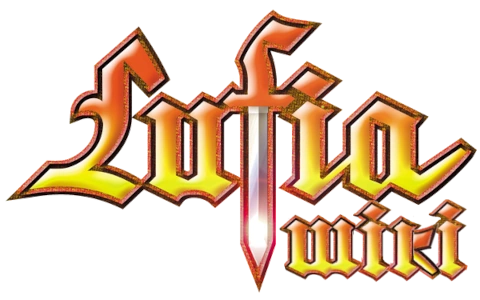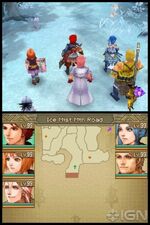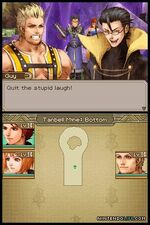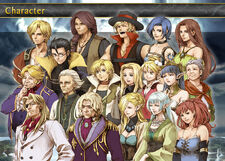Lufia: Curse of the Sinistrals, released as Estpolis: The Lands Cursed by the Gods (エストポリス) in Japan, is an action role-playing game (RPG) co-developed by Neverland and Square Enix for the Nintendo DS. It is a re-imagining of the 1995 Super Nintendo Entertainment System game Lufia II: Rise of the Sinistrals, also developed by Neverland.
Gameplay[]
Unlike the previous Lufia games, this is an action-RPG game similar to games like The Legend of Zelda, Secret of Mana, and Kingdom Hearts. Gameplay is no longer turn-based; players can roam around freely and attack monsters without waiting for the battle scene to occur. Only one character can be playable on-screen. The player can choose a map to go to without fully navigating the map like Lufia: The Ruins of Lore. Players can equip armor and weapons that can give players unique abilities in combat. The game takes advantage of the dual screen. In certain battles or puzzle-solving, certain actions may be disabled or the top-screen is used to navigate actions committed by bosses. Characters do not gain experience from defeating certain bosses. Players can press the feather button on the screen to go back to the stage selection menu. Players can also hit the rewind button to go back to the previous dungeon. These options may not be available if an essential event is going to be triggered in that area. Like in all Lufia games besides Lufia & the Fortress of Doom, the Ancient Cave returns.
Dungeons[]
Each dungeon is filled with puzzles to solve in order to advance. The player can jump and eventually double jump, after progressing past a certain point in the game, push blocks, carry objects, step on switches, open treasure chests, or trigger other events. In battle, the character the player controls is the one who gains the most experience when an enemy is defeated. The MP system that existed in previous Lufia games is not present in this title. Instead, all special abilities use IP, which is rechargeable. The player can choose to perform various types of abilities, including spells and powerful attacks. When an enemy dies, the player can continue attacking the monster until it disappears to gain bonus gold, experience, and possibly items. Each character has a special ability that is required to solve puzzles. Each time a character levels up, that character's HP and IP is restored and any negative effects are removed.
The GRID System[]
As you progress through the game, you can gain access to the GRID system (known as the Mystic Stone Board in the U.S.), which allows you to customize stat boosts to your characters as well as other unique abilities. You place blocks on the grid which is filled with squares. Each block can either be a 2-square, a 3-square that is either a vertical or horizontal line, or a 2x2 4-square. Each square can increase INT, MGC, GUT, and CTR. When placed on the grid, these blocks can be combined to increase the level of the block, up to a maximum of 4 levels. Each character has their own grid of squares, which is either a 6x6 in the four center characters or a 3x12 in the two side characters. Each square with a symbol such as a sword can increase specific stats in a block is placed by them. However, these squares can only be activated if each block all connects to the starting pointer that begins in between the character's block area. Once connected to the pointer, this starts a chain and any block adjacent to it activates. Blocks cannot overlap.
Setting[]
The game begins with a prologue, starting with Maxim, a young monster hunter blessed with impressive and mysterious powers. He first approaches the Soma Shrine where he encounters a giant mech-golem-like monster, who is revealed to be Gades, the Sinistral of Destruction.
Maxim embarks on a journey to destroy the troubles caused by the land. Within his journey, he meets up with his best friend Tia and also meets up with other warriors around the land to defeat the havoc caused by the Sinistrals.
Changes[]
Age[]
The characters in Curse of the Sinistrals are in their early twenties instead of being adults.
Characters[]
- Lexis and Maxim have already met and actively sail the seas with the ship Exelion.
- Iris is not a playable character, but she does travel in the main party.
- Tia's appearance has changed. She is now a redhead who carries a large suitcase and is now a mechanic.
- Dekar has pink hair instead of blue. He also looks less muscular compared to his original appearance.
- Prince Alex is now a child to better illustrate his reckless nature.
- Lexis is no longer a playable character.
- Tia and Dekar can be used past their "ends" in Lufia II. They also become involved in a relationship after Maxim marries Selan.
Weapons[]
- Selan uses chakrams.
- Artea uses guns.
- Dekar can equip any weapon in the game save for the Dual Blade.
Other[]
- The Sinistrals appear at the beginning of the game instead of being revealed halfway through.
- Iris' mission is to gather warriors capable of defeating the Sinistrals, which is almost the exact wording of Seena's ultimate goal in Lufia III.
- Technology has advanced to the point where energy cores (like the type of energy that the Sinistrals are made of, and the energy that the Dual Blade magnifies) are commonplace. One such example is each village being powered and protected by personal energy cores.
- There is no World Map. Like Final Fantasy X-2, players are given a choice of selectable destinations and immediately are transported to said locations.
- After beating the game, you unlock a Retry Mode like in the original Lufia II. If you beat the game in this mode, you get a different ending.
Gallery[]
| This page uses Creative Commons Licensed content from Wikipedia (view authors). |






